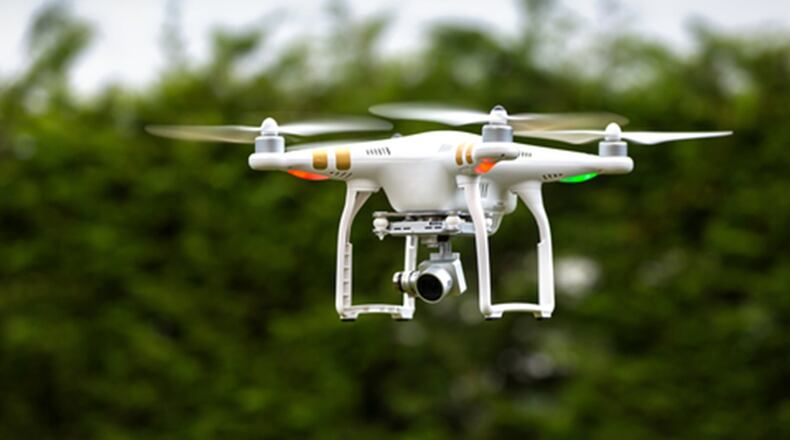More than 40 flights were delayed while others were left circling aloft.
The Federal Aviation Administration says it receives more than 100 drone-sighting reports monthly, including some at two Dayton airports.
FAA data examined by the Dayton Daily News found several cases in past years at the local airport.
On Oct. 14, 2017, the pilot of a Cessna 172 reported spotting at least one drone about 400 feet above while the pilot was approaching a Dayton International Airport runway, according to an FAA sighting report.
The report said the pilot took no evasive action, and Vandalia police were notified.
“In addition the tower also observed another drone in the vicinity of runway 24R,” the report stated. “Airport operations, CMH (John Glenn International Airport), airport police and Vandalia police all notified.”
The pilot of a Piper aircraft at 3,000 feet, east of Dayton-Wright Brothers Airport south of Dayton, reported spotting a UAS beneath the Piper on July 29, 2017.
That report was corroborated by a second aircraft, the FAA said.
“No evasive action taken,” the report said. “Montgomery County sheriff notified.”
The most recent quarterly drone sightings report by the FAA — covering reports from April to June 2018 — tracks more than 780 reports of sightings nationally.
‘Wow, that was close’
The upheaval at Newark illustrated how vulnerable the air-travel system is to the proliferation of inexpensive drones that can weigh as much as 50 pounds and are capable of flying high and fast enough to get in the path of commercial jets, experts on aviation safety and drone technology said. It also raised questions about whether airports are prepared enough to identify drones and prevent them from paralyzing travel and leaving passengers stranded.
“This is a really disturbing trend,” said John Halinski, former deputy administrator of the federal Transportation Security Administration. “It is a real problem because drones are multiplying every day. They really pose a threat in a number of ways to civil aviation.”
Pilots fear drones because tests have proved that they can cause the “take down of an aircraft,” Halinski said. Although technology exists that can detect and deter drones, it is not used at most major airports, he said. “I can’t think of a major airport with anti-drone type of capability,” he said.
On Sept. 23, 2017, a helicopter pilot flying 3.5 miles southeast of Dayton reported a drone passing below the ‘copter at 200 feet. Dayton police were notified, the FAA notice said.
Beyond Dayton, on June 24, 2018, above Bluffton, Ohio, a Piper PA-32 pilot reported seeing a drone passing 200 feet below, while flying at 8,000 feet.
“Wow, that was close. A drone larger than one foot in diameter passed just below us about 200 feet, black in color,” the pilot reported, according to the report.
According to Popular Mechanics magazine, a European drone hobbyist apparently flew a DJI Phantom 2 to a record 11,000 feet up in 2016, taking about three-and-a-half minutes to reach that altitude.
The operator of that drone most likely had to disable software controlling altitude restrictions on the vehicle, the magazine said, adding that in Europe, the regulated limit is 500 feet, while in the U.S., it’s 400 feet.
‘We’ve watched with growing concern’
The University of Dayton Research Institute has performed some limited research on drone-aircraft damage. A video shows UDRI researchers launching a 2.1-pound DJI Phantom 2 quadcopter at the wing of a Mooney M20 aircraft.
“The drone did not shatter on impact, but tore open the leading edge of the wing as it bore into the structure, damaging its main spar,” UDRI said.
“Drones are similar in weight to some birds, and so we’ve watched with growing concern as reports of near collisions have increased, and even more so after the collision last year between an Army Blackhawk helicopter and a hobby drone that the operator flew beyond his line of site,” Kevin Poormon, group leader for impact physics at UDRI, said in the September 2018 post.
Adam Lisberg, North American spokesman for DJI Technology Inc., a manufacturer of small drones, acknowledged that there have been cases where drone operators have made mistakes or have committed malicious acts.
“There will always be a very small number of knuckleheads who do things wrong,” he said.
But he contends that the actual number of bad incidents is “remarkably small.” The number of close-call encounters that are truly dangerous is smaller than widely believed, he said.
“Drones have a pretty good safety record,” Lisberg said. “We think there is an awful lot of hysteria about drone sightings that we think is just unwarranted.”
DJI vehicles come with built-in altitude limitations, and he acknowledged that some operators have figured out how to “hack” around those limits.
But he’s skeptical of many of the FAA sightings reports. In some cases, a pilot may mistake a bird or a bat or a balloon for a UAS, Lisberg said.
The Associted Press contributed to this story.
About the Author

